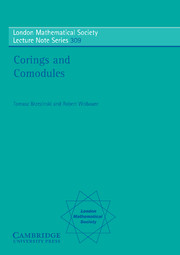5 - Corings and entwining structures
Published online by Cambridge University Press: 10 August 2009
Summary
In this chapter we introduce and analyse the main new class of examples of corings, that is, corings associated to entwining structures. An entwining structure can be understood as a generalisation of a bialgebra. In many applications, in particular in mathematical physics and noncommutative geometry, it can be viewed as a symmetry of a noncommutative manifold. From the Hopf algebra point of view, the introduction of an entwining structure leads to the unification of various categories of Hopf modules studied for over 30 years. Various properties of such modules can be then understood on a more fundamental level once they are formulated in terms of associated corings. Thus in this chapter we introduce the notion of an entwining structure, give numerous examples and study properties of associated corings and comodules. All aspects of the general theory of corings and comodules discussed in the previous chapters are thus illustrated and used in deriving properties of entwined modules.
Throughout this chapter, R is a commutative ring, A is an R-algebra and C is an R-coalgebra. The coproduct of C and any other coalgebra (including bialgebras and Hopf algebras) is denoted by Δ and its counit by ε. The product in A is denoted by µ, and the unit as a map is ⍳ : R → A. If no confusion arises, we also write 1 for the element 1A = ⍳(1R).
- Type
- Chapter
- Information
- Corings and Comodules , pp. 323 - 356Publisher: Cambridge University PressPrint publication year: 2003

